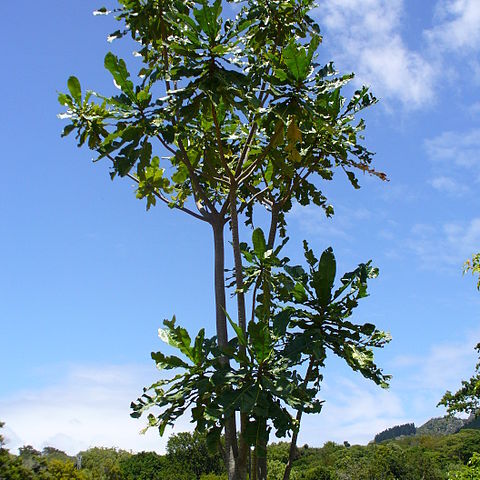Stamens as many as the corolla lobes and alternating with them, exserted, equal; filaments short or very short, mostly shorter than the anthers, entirely connate into a short tube or occasionally connate for two–thirds of their length, inserted near the apex of the corolla tube; anthers white or creamy, often partially green, sometimes brownish, lanceolate, obtuse or sometimes acute at the apex, usually sagittate at the base; cells 2, parallel and if sagittate only at the base divergent, dehiscent throughout by a longitudinal split.
Corolla white, creamy, violet, violet–blue, mauve, or sometimes pale yellow, the limb often paler than the tube which is sometimes green, actinomorphic, tubular, usually not contracted when mature, thick, fleshy, brittle, also when living, often sweet–scented; tube approximately cylindrical, more or less gradually widened towards the throat; lobes 8–16, contorted in bud usually turned to the right, spreading or recurved, elliptic to lanceolate, usually obtuse, entire.
Leaves opposite, those of a pair equal or unequal, petiolate or sessile; bases or petioles joined, often auriculate, and, especially in young plants more or less conspicuously ligulate at the base; lamina soft and brittle or coriaceous when living, membranaceous or papyraceous and often brittle, or coriaceous when dry, entire or minutely crenate; margin recurved or not; secondary veins conspicuous or not.
Sepals 4, green, creamy, or occasionally partially orange, free, or sometimes connate at the base (A. laxiflora), orbicular or nearly so, concave, decussate, appressed to the corolla tube and later to the fruit, usually rounded at the apex, entire, the 2 inner ones usually becoming retuse or tom by the development of the corolla, often spreading when dry, often enlarged under the fruit.
Ovary superior, ovoid–conic, cylindric, or obovoid–cylindric, 4–celled; style thick, about as long as the corolla tube, persisting during a short period after the corolla is shed; stigma large, usually obovoid–cylindric and apically bilobed, often slightly laterally compressed.
Fruit a berry, dark green or yellow, hard, globose or ellipsoid (irregular or regular indentations or furrowings are due to shrinkage and are always artificial, rounded at the apex, sometimes apiculate; wall usually thick; septa thin.
Inflorescence terminal, erect, sometimes pendulous when in fruit, almost dichasial, 1–5 times branched, easily breaking at the nodes when dry.
Seeds obliquely ovate–circular or irregularly polyhedral in outline, flattened, medium to dark brown, slightly verrucose, faveolate.
In continental species mostly only one flower of each inflorescence open at a time.
Lower bracts foliaceous, the others usually very small, triangular or ovate.
In each cell one large bilobed placenta with numerous ovules on both sides.
Small colleters in one rank in the axils of the leaves, bracts, and sepals.
Entirely glabrous trees, 1–35 m. high, shrubs, or lianas.
Stipules intrapetiolar (ligular).
